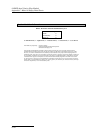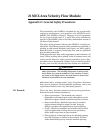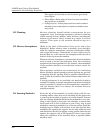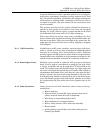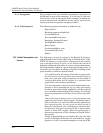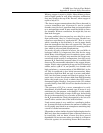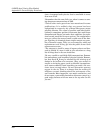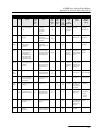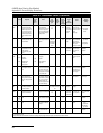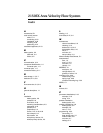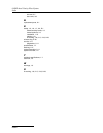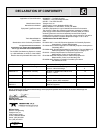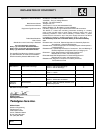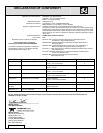
2150EX Area Velocity Flow Module
Appendix D General Safety Procedures
D-8
Hydrogen
Sulfide
H
2
S Irritant and poisonous vol-
atile compound. Rotten
egg odor in small concen-
trations. Exposure for 2 to
15 min. at 0.01% impairs
sense of smell. Odor not
evident at high concentra-
tions. Colorless. Flamma-
ble.
1.19 Impairs sense of smell, rap-
idly as concentration
increases. Death in few min-
utes at 0.2%. Exposure to
0.07 to 0.1% rapidly causes
acute poisoning. Paralyzes
respiratory center.
200
to
300
20 4.3
45.0
Near bottom,
but may be
above bottom
if air is heated
and highly
humid.
Coal gas, petro-
leum, sewer gas.
Fumes from blasting
under some condi-
tions.
Sludge gas.
1. H
2
S Ampoule.
2. 5% by weight
lead acetate
solution.
Methane CH
4
Simple asphyxiant.
Colorless, odorless, taste-
less, flammable.
0.55 Acts mechanically to deprive
tissues of oxygen. Does not
support life.
Probably no
limit, pro-
vided oxygen
percent-age
is sufficient
for life.
—5.0
15.0
At top, increas-
ing to certain
depth.
Natural gas, sludge
gas, manufactured
gas, sewer gas.
Strata of sedimen-
tary origin. In
swamps or marshes.
1. Combustible
gas indicator
2. Oxygen defi-
ciency indicator.
Nitrogen N
2
Simple asphyxiant. Color-
less, tasteless. Non-flam-
mable. Principal
constituent of air. (about
79%).
0.97 Physiologically inert. — — —
—
Near top, but
may be found
near bottom.
Sewer gas. sludge
gas. Also issues
from some rock
strata.
Oxygen
deficiency
indicator
Nitrogen
Oxides
NO
N
2
O
NO
2
Colorless
Colorless,
sweet odor.
Reddish-brown.
Irritating odor.
Deadly poison
1.04
1.53
1.58
60 to 150 ppm cause irritation
and coughing.
Asphyxiant.
100 ppm dangerous.
200 ppm fatal.
50 10 —
—
Near bottom Industrial wastes.
Common air pollut-
ant.
NO
2
detector tube
Oxygen O
2
Colorless, odorless, taste-
less. Supports combus-
tion.
1.11 Normal air contains 20.8% of
O
2
. Man can tolerate down to
12%. Minimum safe 8 hour
exposure, 14 to 16%. Below
10%, dangerous to life. Below
5 to 7% probably fatal.
———
—
Variable at dif-
ferent levels.
Oxygen depletion
from poor ventilation
and absorption, or
chemical consump-
tion of oxygen.
Oxygen deficiency
indicator
Ozone O
3
Irritant and poisonous.
Strong electrical odor.
Strong oxidizer. Colorless.
At 1 ppm, strong sulfur-like
odor.
1.66 Max. naturally occurring
level is 0.04 ppm. 0.05 ppm
causes irritation of eyes and
nose. 1 to 10 ppm causes
headache, nausea; can
cause coma. Symptoms sim-
ilar to radiation damage.
0.08 0.04 —
—
Near bottom Where ozone is used
for disinfection
Detectable odor
at 0.015 ppm
Sludge
Gas
—*** Mostly a simple asphyx-
iant. May be practically
odorless, tasteless.
Variable Will not support life. No data. Would
vary widely with composi-
tion.
5.3
19.3
Near top of
structure
From digestion of
sludge
See components
Sulfur
Dioxide
SO
2
Colorless, pungent odor.
Suffocating, corrosive, poi-
sonous, non-flammable.
2.26 Inflammation of the eyes. 400
to 500 ppm immediately fatal.
50
to
100
10 —
—
At bottom, can
combine with
water to form
sulfurous acid.
Industrial waste,
combustion, com-
mon air pollutant.
Detectable taste and
odor at low concen-
tration
Toluene C
5
H
12
to
C
9
H
20
Colorless, benzene-like
odor.
3.14 At 200-500 ppm, headache,
nausea, bad taste, lassitude.
200 100 1.27
7.0
At bottom Solvent Combustible gas
indicator
Turpentine C
10
H
16
Colorless, Characteristic
odor.
4.84 Eye irritation. Headache, diz-
ziness, nausea, irritation of
the kidneys.
— 100 At bottom. Solvent, used in
paint
1. Detectable odor
at low
concentrations.
2.Combustible
gas indicator.
Xylene C
8
H
10
Colorless, flammable 3.66 Narcotic in high concentra-
tions. less toxic than ben-
zene.
—1001.1
7.0
At bottom Solvent Combustible gas
indicator
* Percentages shown represent volume of gas in air.
** For concentration over 0.3%.
***Mostly methane and carbon dioxide with small amounts of hydrogen, nitrogen, hydrogen sulfide, and oxygen; occasionally traces of carbon monoxide.
Table D-1 Hazardous Gases (Continued)
Gas Chemical
Formula
Common
Properties
Specific
Gravity or
Vapor
Density
Air = 1
Physiological
Effect*
Max
Safe
60 Min.
Exposure
ppm
Max.
Safe
8 Hour
Exposure
ppm
Explosive
Range
(% by vol.
in air.)
Limits
lower/upper
Likely
Location
of
Highest
Concentration
Most
Common
Sources
Simplest and
Cheapest
Safe Method
of Testing



